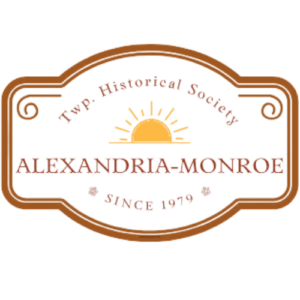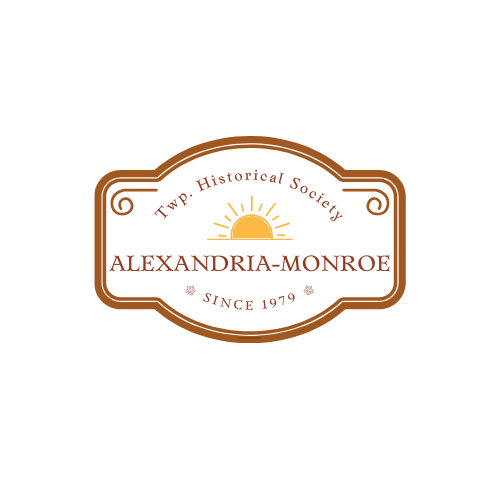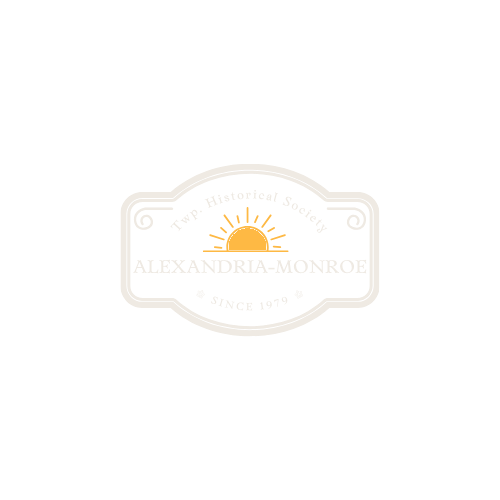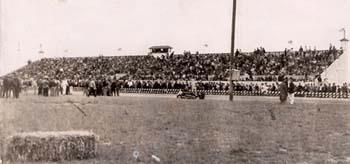From 1941 through 1967 Armscamp Speedway hosted a variety of races on the quarter-mile asphalt oval track and a one-eighth mile infield track.
Built in April 1941 by Joe Armstrong and Frank Scampmorte of Anderson, Armscamp Speedway was located on the north side of Alexandria off Indiana 28. Opening day for the track was July 4th of that year
The entrance to Armscamp ran beneath a wooden arch that featured an illustration of a midget race car. Patrons parked in an open field near the track that was equipped with lighting for night racing. On any given Saturday or Sunday, 4,000 to 5,000 race fans packed the bleachers to watch local, regional, or nationally known drivers compete for prize money, trophies, or bragging rights.
The format at Armscamp was similar to that of Anderson’s Sun Valley Speedway. Jalopies, midget and sprint cars, and the crowd-pleasing Figure 8 were regular features at the Alexandria racetrack. The heat races were given a Le Mans-type start with drivers dashing to their cars once the green flag dropped.
During this era of auto racing, seat belts were an option and harnesses were unheard of, making the Le Mans start an easy task. That is unless you were a one-legged driver named Bill Schindler who found much difficulty running to and settling into his race car. But once there, Schindler raced with the best of them using a hand brake mounted outside the car’s cockpit.
Racing ceased at Armscamp Speedway in 1943 and 1944 for the war years but reopened the following year when the Office of Defense Transportation permitted a relaxation of war time travel restrictions.
Armscamp hosted the Consolidated Midget Racing Association competitions in 1946, with Harold Hurst of Muncie serving as the track director and Cincinnati’s own Ralph Ormsby as race starter. Though Armscamp was one of the more popular and successful racing venues in the region, 1946 was a year that the speedway had its share of tragedies.
On Sept. 4, Huston Bundy was killed while competing at Armscamp, the first of several drivers to lose their lives there. Two week later, a fire broke out in the early evening hours at the track causing $20,000 worth of damage to the grandstand area.
Bernie Morgan, who co-owned the track with his brother Lou, believed that the fire was enhanced by exploding cans of paint stored beneath the wooden grandstand structure. Spectators who gathered to watch the fire helped salvage folding chairs, an amplifier for the public address system, supplies used for track maintenance, and food items from the concession stand. Two American flags hanging from the grandstand went up in flames during the inferno. Smoke from the burning grandstand could be seen as far away as Fairmount located 12 miles to the north. Residents in the small Grant County town first thought that the entire town of Alexandria had been engulfed in flames.
Though Armscamp Speedway suffered financially from the fire, racing resumed on Sept. 19 with over 5,000 spectators on hand to cheer for their favorite drivers. That day’s midget car race was won by Bob Breading of Indianapolis, who captured his third straight consecutive win at Armscamp. In the early 1950s, Paul “Whitey” Karnes of Marion took over ownership of Armscamp Speedway. Karnes made improvements by adding a new lighting system and converting the clay track to a hard surface. The changes made Armscamp one of the best and fastest tracks of its size in the Midwest. With help from the Alexandria Lions Club, Karnes initiated the “Little 500 Bicycle Derby” for local youngsters. At the inaguaral event Harold Granger, Danny Custer, and Tom Willis were victorious in their respective races.
Through the 1950s many drivers made names for themselves at Armscamp Speedway. One of the more popular drivers was Bill Holloway of Muncie, who won several races at Mount Lawn Speeday in New Castle, Funk Speedway in Winchester, and Anderson’s Sun Valley Speedway. In 1952 and 1953, Holloway won over 40 races at Armscamp which soon came to be the driver’s favorite race track. Holloway built race cars from the ground up with help from his brother Charles.
Beezer Humphries, Gene Christy, Red Barber, Davey Crockett, and Guy Smith also won numerous races at Armscamp. Audie Swartz of Muncie won the 100-lap championship at Armscamp in 1952, setting a new track record for speed during the race.
One of the bigger events to take place at Armscamp Speedway was the celebration of Independence Day of 1956. Races were held four nights in a row including a 200-lap mid-season championship race on July 4. The 200-lap race was four times the length of main events held at Armscamp. Fifty-lap jalopy races took place on Thursday, Friday, and Saturday night that week with Bob Schopp of New Castle claiming his first ever victory at the track.
Midget and sprint car races continued at Armscamp into the mid-1960s, as did jalopy racing and the Little 500 Bicycle Derby. Armscamp Speedway hosted its last race during the summer of 1967. All that remains of Armscamp Speedway is the outer wall; most of it is hard to see as it is covered by brush. But that does not keep die-hard fans from remembering the pilgrimages they made to one of the well-known racetracks of its time.





